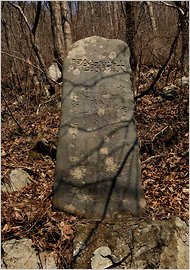A memory stone is an old inscribed tablet found in Japan in areas that have been ravaged by a tsunami. The stones are markers, reminders, that a tsunami has reached the place at which the stone is set, and to not build anything between the sea and the stone. Here is an image of an actual memory stone in Aneyoshi, Iwate Prefecture, northern Japan:

High dwellings are the peace and harmony of our descendants…. Remember the calamity of the great tsunamis. Do not build any homes below this point.
A centuries-old tablet warns of tsunamis in the town of
Aneyoshi, Iwate Prefecture, Northern Japan
Aneyoshi, Iwate Prefecture, Northern Japan
The synopsis of the work is as follows:
After the March 2011 Japanese earthquake and tsunami, a mysterious
woman appears with a memory stone in Houston's Japanese garden. The
woman's powers cause two Japanese-American women to relive crucial
moments from their respective pasts. As their common ancestry creates a
bond between them, they question how they can support those who have
been affected by the devastation of the earthquake and tsunami in
Japan.There are four singers/characters in this chamber opera:
- THE MYSTERIOUS WOMAN: mezzo-soprano with depth and darkness to the voice. Japanese. Old but ageless, dressed as a Japanese gardener would dress. She has died twice: first in Hiroshima, then again in the March 2011 tsunami
- REI: lyric soprano, mid-thirties, ballet dancer in the Houston Ballet, elegant bearing. Originally from Japan, but moved to the U.S. with her family when she was ten
- THE TIMELESS MAN: baritone, plays two characters; Rei’s father, a middle-aged businessman dressed in a suit and tie, and one of the fourteen craftsmen who came to Houston to build the Japanese garden in Hermann Park
- HANA: mezzo-soprano, although considerably lighter and higher than the Woman, late-fifties, born in Houston to a Japanese mother and a U.S. father, looks as if she doesn’t take care of herself as well as she should
This is the first time I have composed an operatic work. I approached the genre cautiously, with reverence, and dare I say with slight hesitation. Still, what I have really enjoyed about working on this particular piece more than anything else is its collaborative nature. As a creative team, the librettist, composer, and director collaborate to create a synergized artistic vision. The result is a an aesthetic experience that I believe is far more rich than anything I could have created by myself.
Director Matthew Ozawa giving a design presentation
No comments:
Post a Comment
Note: Only a member of this blog may post a comment.